Virtual reality: Lessons from the past for Oculus Rift
- Published
Marc Cieslak looks at how the Oculus Rift and game developers hope to bring virtual reality into the 21st century.
Virtual reality was all the rage a couple of decades ago and looked as if it could become the video games industry's next big thing. But despite public interest and millions of dollars of research, the concept flopped.
Now, with excitement building for the release of a new VR helmet - the Oculus Rift - it is worth asking what went wrong the first time round, and can any lessons be learned?
Sandwiched among old consoles in a second-hand video games shop is a vibrant box with a machine inside that was meant to change the world… and play 3D Tetris.
Released in 1994 by Nintendo, Virtual Boy was the first games console marketed with out-of-the-box VR for a relatively-affordable $180 (£115).
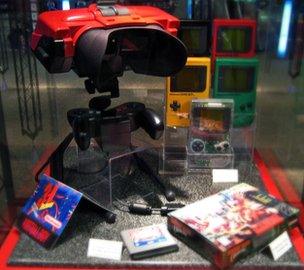
The Virtual Boy failed to match Nintendo's success with its SNES and Game Boy machines
It proved to be a dud. Gamers complained about the lack of motion tracking - the ability to match the view to movements of the player's head - and even headaches from the graphics which could only be shown in red.
Despite being launched at the forefront of a VR-mania, it vanished - like the craze - amid unrealistic expectations.
"In the 80s and 90s there was so much hype we had to do expectation management," says Scott Fisher.
He is founding chairman of the Interactive Media Division at the University of Southern California's School of Cinematic Arts and previously worked at Atari and Nasa.
"What's frustrating now that VR's a hot topic again is that we're seeing a lot of reinventing the wheel. There's good research [already] out there. It's been around for years."
Slow start
Imagine being Paul McCartney, walking out on stage at the height of Beatlemania - that was the promise of virtual reality: the ability to be whoever and do whatever you wanted.
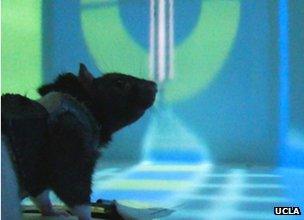
The only limit would be the software designer's imagination.
But in practice the "reality" offered looked very different to real life, and proved awkward to operate.
From eye-piece-like consoles to arcade pods, VR rigs were cumbersome and expensive.
The technology can be traced back to 1962 and the launch of the Sensorama - a stereoscopic 3D movie booth, called an "experience theatre" into which viewers placed their head to be transported "into another world".
Four years later the US Air Force developed its first computer-controlled flight simulator.
That was followed in 1968 by a head-mounted display developed by a Harvard University professor which showed wire-frame graphics that moved as the wearer turned their head.
The term "virtual reality" itself was made popular by California-based technologist Jaron Lanier who founded VPL Research in 1984 - a firm which made early VR headsets and data-gloves.
Among buyers of the kit was Nasa, where a researcher adapted it to be used as a control system for later Mars Rover pilots.
But it wasn't until the early-90s that VR really hit the mainstream.
Movies including The Lawnmower Man, Virtuosity and Johnny Mnemonic and novels such as Neal Stephenson's Snow Crash and Michael Crichton's Disclosure entranced the public with the promise of immersive computer-created worlds.
Start-ups capitalised on the opportunity, trying to create kit that would let the public visit cyberspace.
But the phenomenon was short-lived - and mostly limited to video games arcades - as the firms struggled to match the quality of the graphics depicted in fiction, failed to agree on a standard format, and put off customers with high prices.
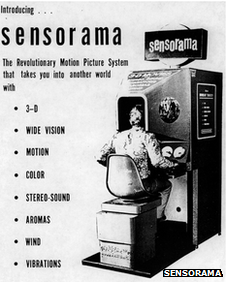
The Sensorama was advertised as costing $1.5m in the 1960s
"With consumers, VR hasn't been successful. But it's a success for industry," says Mr Lanier.
"Every car company and boat builder uses VR to build vehicles. But there's still no place for consumers to try VR."
Consumer VR is often disappointing: it's expensive to develop, and there are technical limitations on hardware, processors and resolution.
"Thirty years ago we didn't have real-time graphics to keep up with head or body motion," Mr Fisher says. "People would get sim-sick because of lag."
Computing power has now had a chance to catch up. Moore's Law states that the number of transistors on a chip will double approximately every two years.
So processors should now be more than 1,000 times more powerful than in 1993.
Yet VR systems remain outside most consumers' budgets.
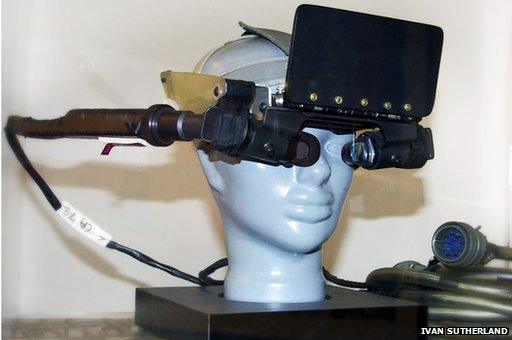
A Harvard professor developed one of the first VR head-mounted displays
Even so, some of the related technologies have worked their way into homes.
Mr Lanier helped develop the Xbox's original Kinect motion-tracker, something he describes as one of the "baby steps of bringing VR to consumers".
The motion-tracking technologies used by Nintendo's Wii consoles also had their roots in VR - but Mr Lanier admits the products aren't "great".
"There's nothing you can do to make the stuff cheaper," he adds.
"It's happening as fast as it can."
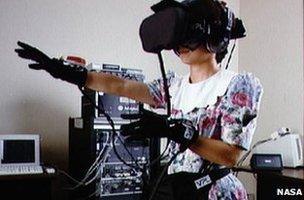
Nasa adapted a commercially-available VR kit to build a control system for Mars Rovers
The big hope on the horizon for the games industry is Oculus VR, a California-based firm which raised $2.4m via crowdfunding site Kickstarter to develop a VR headset.
"Virtual reality got featured in movies, TV shows, games, and books as a kind of holy grail technology about to change the world," Palmer Luckey, the firm's founder tells the BBC.
"Unrealistic portrayals led to lots of hyperbolic media coverage, further bolstering the public perception that (VR) was more advanced.
"[But] computers are finally powerful enough to render realistic virtual worlds at high frame rates, and the mobile phone industry has massively improved the price, size, and performance of display and sensor technologies.
"We may be a long way from making virtual reality perfect, but what exists today is still an experience far beyond what any game can do with a TV."
Even so, it will take more tech advances to succeed. Part of the reason the Virtual Boy failed was because it was launched with just three games under its belt.
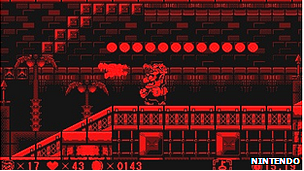
Nintendo's Virtual Boy was limited to showing graphics in the colour red
"To succeed among consumers there needs to be software, games - all of it," Mr Fisher says. "That's important."
And not everyone believes VR is finally at its breakthrough moment.
"Every few years there's some entrepreneur," says Mr Lanier.
"There've been things like Oculus [before].
"They're cute and remind me so much of myself when I was a kid… I just don't know if they'll make it."
- Published8 August 2013
- Published12 June 2013
- Published7 June 2013